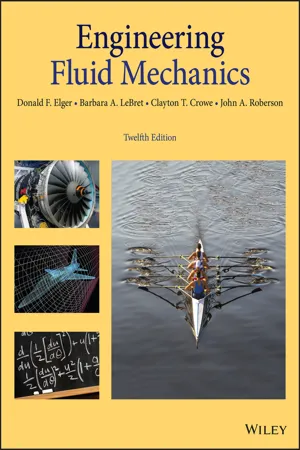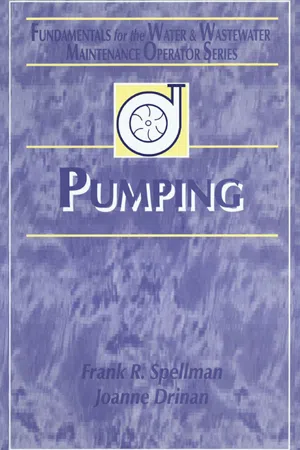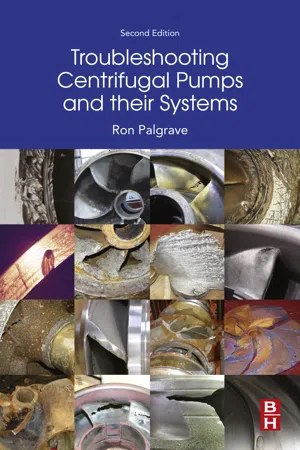Technology & Engineering
Axial Flow Pump
An axial flow pump is a type of pump that uses an impeller with vanes to create a flow in the direction parallel to the pump shaft. This design allows for the movement of large volumes of water at relatively low heads. Axial flow pumps are commonly used in applications such as irrigation, drainage, and water supply systems.
Written by Perlego with AI-assistance
Related key terms
1 of 5
8 Key excerpts on "Axial Flow Pump"
- Allan D. Kraus, James R. Welty, Abdul Aziz(Authors)
- 2011(Publication Date)
- CRC Press(Publisher)
It was men-tioned earlier that Axial Flow Pumps are encountered in numerous applications. The distinction between axial and centrifugal flow is in the direction of fluid flow through the pump. In axial flow, the fluid moves parallel to the axis of rotation and in the centrifugal case, the flow is turned 90 ◦ normal to the rotational axis. It seems reasonable that there is an intermediate case in which the flow has both axial and normal components. This intermediate configuration is called mixed flow . The choice of a centrifugal, mixed or Axial Flow Pump is determined by choosing an ap-propriate combination of head and volumetric flow rate that will achieve the peak efficiency for a given pump configuration. A useful parameter, in this regard, is obtained by eliminating the diameter between Q Q and C H . This operation yields the specific speed , N S , defined as N S = C 1 / 2 Q C 3 / 4 H (18.26) Values of N S , at peak efficiency, for pump configurations ranging from centrifugal to axial are shown in the Figure 18.13 (lower axis). Also shown in the figure (upper axis) are values of N S expressed in what we call U. S. Customary Units . This parameter is dimensional and has numerical values determined using English-system dimensions as N s d = ( , rpm)[ ˙ V, gpm] 1 / 2 [ h, ft] 3 / 4 (18.27) 8.0 7.0 6.0 5.0 Axial Flow Mixed Flow Radial Flow Vanes Vanes Specific Speed, N s Specific Speed, N sd Vanes Vanes Vanes Hub Hub Axis of Rotation Impeller Hub Impeller Shrouds Impeller Shrouds Impeller Shrouds 4.0 3.0 2.0 1.0 0.9 0.8 0.7 0.6 0.5 0.4 0.3 0.2 500 600 700 800 900 1000 1500 2000 3000 4000 5000 6000 7000 8000 9000 10000 15000 20000 Hub Hub FIGURE 18.13 Specific speed variation for various impeller configurations. (Adapted from Hydraulic Institute Standards , 14th ed., Hydraulic Institute, Cleveland, OH, 1983.)- eBook - PDF
Turbomachinery
Design and Theory
- Rama S.R. Gorla, Aijaz A. Khan(Authors)
- 2003(Publication Date)
- CRC Press(Publisher)
2 Hydraulic Pumps 2.1 INTRODUCTION Hydraulics is defined as the science of the conveyance of liquids through pipes. The pump is often used to raise water from a low level to a high level where it can be stored in a tank. Most of the theory applicable to hydraulic pumps has been derived using water as the working fluid, but other liquids can also be used. In this chapter, we will assume that liquids are totally incompressible unless otherwise specified. This means that the density of liquids will be considered constant no matter how much pressure is applied. Unless the change in pressure in a particular situation is very great, this assumption will not cause a significant error in calculations. Centrifugal and Axial Flow Pumps are very common hydraulic pumps. Both work on the principle that the energy of the liquid is increased by imparting kinetic energy to it as it flows through the pump. This energy is supplied by the impeller, which is driven by an electric motor or some other drive. The centrifugal and Axial Flow Pumps will be discussed separately in the following sections. 2.2 CENTRIFUGAL PUMPS The three important parts of centrifugal pumps are (1) the impeller, (2) the volute casing, and (3) the diffuser. 2.2.1 Impeller The centrifugal pump is used to raise liquids from a lower to a higher level by creating the required pressure with the help of centrifugal action. Whirling motion is imparted to the liquid by means of backward curved blades mounted on a wheel known as the impeller. As the impeller rotates, the fluid that is drawn into the blade passages at the impeller inlet or eye is accelerated as it is forced radially outwards. In this way, the static pressure at the outer radius is much higher than at the eye inlet radius. The water coming out of the impeller is then lead through the pump casing under high pressure. - eBook - PDF
- Donald F. Elger, Barbara A. LeBret, Clayton T. Crowe, John A. Roberson(Authors)
- 2019(Publication Date)
- Wiley(Publisher)
The major practical difference between axial- and radial-flow pumps so far as the user is concerned is the difference in the performance characteristics of the two designs. The dimensional performance curves for a typical radial-flow pump operating at a constant speed of rotation are shown in Fig. 14.10. The corresponding dimensionless performance curves for the same pump are shown in Fig. 14.11. Note that the power required at shutoff flow is less than that required for flow at maximum efficiency. Normally, the motor used to drive the pump is chosen for conditions corresponding to maximum pump efficiency. Hence, the flow can be throttled between the limits of shutoff condition and normal operating conditions Discharge, m 3 /s Efficiency, percent 0 0.05 0.10 0.15 0.20 20 0 40 60 100 80 0.25 0 50 100 200 150 250 Head (ΔH), m Power input, kW Efficiency Head, m; power, kW N = 2133.5 rpm n = 35.6 rps D = 37.1 cm FIGURE 14.10 Performance curves for a typical centrifugal pump; D = 37.1 cm. [After Daugherty and Franzini (4).] 0 1 2 3 4 5 6 0 0.04 0.08 0.12 0.16 0 0.25 0.50 0.75 1.00 C P and efficiency C Q C H C P C H Efficiency, η FIGURE 14.11 Dimensionless performance curves for a typical centrifugal pump, from data given in Fig. 14.10. [After Daugherty and Franzini (4).] 374 CHAPTER 14 • TURBOMACHINERY with no chance of overloading the pump motor. In this latter case, a radial-flow pump offers a distinct advantage over axial-flow pumps. Radial-flow pumps are manufactured in sizes from 1 hp or less and heads of 50 or 60 ft to thousands of horsepower and heads of several hundred feet. Figure 14.12 shows a cutaway view of a single-suction, single-stage, horizontal-shaft radial pump. Fluid enters in the direc- tion of the rotating shaft and is accelerated outward by the rotating impeller. There are many other configurations designed for specific applications. Example 14.4 shows how to find the speed and discharge for a centrifugal pump needed to provide a given head. - eBook - PDF
Pumping
Fundamentals for the Water and Wastewater Maintenance Operator
- Frank R. Spellman, Joanne Drinan(Authors)
- 2001(Publication Date)
- CRC Press(Publisher)
2 MIXED FLOW IMPELLER PUMPS Mixed flow impellers impart energy partially by centrifugal force and partially by axial force, because the vanes act partially as an axial com-pressor. This type of pump has a single inlet impeller with the flow enter-ing axially and discharging in an axial and radial direction (see Figure 3.6). Specific speeds of mixed flow pumps range from 4200 to 9000. Jt. Note: Mixed flow impeller pumps are suitable for pumping untreated ~ wastewater and stormwater. They operate at higher speeds than IMPORTANT the radial flow impeller pumps, are usually of lighter construction, and, where applicable, cost less than corresponding non-clog pumps. Impellers may be either open or enclosed, but enclosed is preferred. 12 12 Metcalf & Eddy, Wastewater Engineering: Collection and Pumping of Wast ew at e r. Tchobanoglous, G. (ed.). New York: McGraw-Hill Book Company, p. 281 , 1981. 60 Introduction to Centrifugal Ptmps Figure 3.6 !lllllliliiJ II IIIIIJiiliiJIJiiliiJr Mixed flow pump . 3 AXIAL FLOW IMPELLER PUMPS (PROPELLER PUMP) Axial flow impellers impart energy to the water by acting as axial flow compressors (see Figure 3.7). The Axial Flow Pump has a single inlet impeller with flow entering and exiting along the axis of rotation (along the pump drive shaft). Specific speed is greater than 9000. The pumps are used in low-head, large-capacity applications, such as 1 municipal water supplies 6 irrigation 6 drainage and flood control 6 cooling water ponds 6 backwashing 6 low service applications (e .g., they carry water from the source to the treatment plant) Jt. Important Point: Radial flow and mixed flow centrifugal pumps ;1 can be designed for either single or double suction operation. In a M'ORTANT single suction pump, water enters only one side of the impeller. In a double suction pump, water enters both sides of the impeller. Thus, for an impeller with a given specific speed, a greater flow rate can be expected from a double suction pump. - eBook - PDF
- Carl J. Schaschke(Author)
- 2015(Publication Date)
- CRC Press(Publisher)
118 Solved Practical Problems in Fluid Mechanics Solution A centrifugal pump is a mechanical device used to transport fluids by way of an enclosed impeller rotating at high speed. This widely used device involves the fluid being fed in axially at the centre or eye of the impeller and thrown out in a roughly radial direction by centrifugal action. The large increase in kinetic energy which results is converted into pressure energy at the pump outlet either by using an expanding volute chamber or a dif-fuser, which can be measured using gauges such as those in Figure 5.10. There are considerable variations in impeller design, but virtually all have blades, which are curved, usually backward to the direction of rotation. This arrangement gives the most stable flow characteristic. The head developed depends not only on the size and rotational speed of the pump but also on the volumetric flow rate. The bench testing of equipment is routinely used for the validation of new process equipment or for the testing of existing equipment parameters. It can be carried out under controlled conditions, and the data obtained can be analysed in detail. The testing of the performance of centrifugal pumps typi-cally involves mounting the pump such that the flow and pressure across the FIGURE 5.10 Pressure Gauges on a Centrifugal Pump (Photo from C.J. Schaschke.) 119 Pumps suction and delivery side can be measured. With a wide variation in their design and performance, the most efficient form of operation is limited to a range of flows. The power exerted on the fluid by the pump is the product of the angular velocity of the impeller and its torque: P T o = ω (5.16) where the angular velocity is ω π = 2 60 N (5.17) and the torque is T = Fr (5.18) For a torque arm of 0.179 m, the power input is therefore P NF NF o in ( ) . - eBook - PDF
- Heinz P. Bloch, Claire Soares(Authors)
- 1998(Publication Date)
- Butterworth-Heinemann(Publisher)
Chapter 12 Axial Flow Compressors* As stated in the introduction to the preceding chapter, dynamic compressors are machines in which air or gas is compressed by the mechanical action of rotating components imparting velocity and pressure to the air or process gas. In an axial compressor, as the name implies, flow is in the axial direction, i.e., parallel to the axis of rotation. Axial compressors are basically high-flow, low-pressure machines, in contrast to the lower flow, high-pressure centrifugal compressors. Figure 12-1 shows the performance characteristics of a centrifugal and an axial compressor at constant speed for the same operating conditions. From this figure, a direct comparison of the characteristics is easy. The turndown capability of the centrifugal is much larger than that of the fixed geometry axial. The range of operation is greatly increased through the use of variable geometry. FIELD OF APPLICATION Axial flow compressors have found wide use in refineries, petrochemical plants, and steel mills. Particularly in refineries, applications formerly handled by centrifugal units are now handled by axial flow compressors. This is due to several trends: first, plant sizes are growing dramatically, which brings the air requirements up into a desirable range for axial compressors; second, due to rising energy costs, there exists an increasing trend toward higher efficiencies; and third, technological improvements have made axial compressors more reliable than ever before. Axial compressors are generally more efficient than centrifugal compressors in the common flow range, depending on conditions. An axial compressor will also generally be smaller than a centrifugal compressor designed for the same flow rate. Although the axial flow compressor requires more stages due to the lower pressure rise per stage, the diametral size is much greater in a centrifugal compressor in order to pass the required air flow. - eBook - PDF
Incompressible Flow Turbomachines
Design, Selection, Applications, and Theory
- G.F. Round(Author)
- 2004(Publication Date)
- Butterworth-Heinemann(Publisher)
Pumps 135 Figure 4-37 A “canned” pump design. increase the efficiency, then c 2 would become identical to the axial velocity, c a , and angle b 2 would become less than angle b 1 . There are, of course, other constraints on the amounts by which such changes can be made, such as blade speed. Semiaxial pumps may have fixed or rotatable blades. They are diagonal-flow pumps with their blades usually projecting forward in the axial direction. Figure 4-43 shows a side and end elevation of a semiaxial pump, with Figure 4-44 showing a three-dimensional view of a typical impeller of this sort. 136 Incompressible Flow Turbomachines Casing Impeller vane Diffuser vane Figure 4-38 A typical mixed-flow pump design with diffuser blades. The Deriaz pump, an impeller of which is illustrated in Figures 4-45(a)–(c), is the pump counterpart of the Deriaz turbine. It is a semiaxial pump with rotatable blades. Figure 4-45(a) is a plan view of the impeller showing the blades closed; Figure 4-45(b) is the same view with the blades fully open, that is, allowing the flow to be maximum. Figure 4-45(c) is a side elevation of the pump showing the position of a blade. A distinct advantage of the Deriaz pump is that it allows good flow control. 4.5.1 Unbounded Axial Impellers or Propellers The extension of the theory and application of all that has been discussed in Section 4.4 to an unbounded axial impeller or propeller should be self-evident. The equations to be derived in this section will be equally applicable to air flows, that is, aerodynamics. We first consider the unbounded flow past a propeller as shown in Figure 4-46. Pumps 137 Figure 4-39 A commercial mixed-flow pump designed for chemical service. The control surface used in this analysis is the surface bounded by the top and bottom stream-lines and the upstream and downstream parallel streams of Figure 4-46. - Ron Palgrave(Author)
- 2019(Publication Date)
- Butterworth-Heinemann(Publisher)
Firstly, a clarification: This book is entitled Troubleshooting Centrifugal Pumps and their Systems. A large part of the pump population can be described as rotary machines, as opposed to, say, reciprocating. Of the rotary segment, some have a positive displacement volume, such as gear pumps, lobe pumps and the like. Some do not have a positive displacement. These have been termed rotodynamic pumps. As we shall see, this includes pumps where, at one extreme, the flow approaches the rotor axially, but is turned to a radial direction as it has work done on it. These are termed Radial Flow machines. At the other extreme, the flow also approaches axially but leaves more or less axially. These are often called propeller pumps, or more exactly Axial Flow machines. Between these two extremes are machines where again the flow approaches axially, but leaves at some angle between radial and axial. These are known as Mixed Flow or diagonal flow pumps. The term centrifugal pump strictly relates to the first group only, those where the flow leaves radially. In these cases, centrifugal forces are by far the dominant contributor to the way in which pump pressure head is created. But this is not the only contributor. At the other extreme, in cases where the liquid leaves the impeller axially, it does so at the same radial distance from the shaft as when it entered. With no change of radius, there can be no obvious centrifugal force. Instead the pressure head is generated almost entirely by a different mechanism. In the case of mixed flow pumps, the contributions from both mechanisms might be comparable.In fact, most practical members of this part of the pump family generate head from combinations of these two mechanisms. However, the term Centrifugal Pump has come to describe any member of the family (Fig. 3.1 ).The main purpose of almost every centrifugal pump is to create flow in a liquid system. To do so they have to simultaneously generate pressure head in the liquid. This pressure head is then dissipated by the liquid system resistance while handling the above-mentioned flow. Though the pump still has to generate pressure head as a by-product, its chief purpose is to create a specified system flow. On very rare occasions, centrifugal pumps are installed for the main purpose of creating hydrostatic pressure. But generally, other classes of pumping machine are better suited to this aim.Fig. 3.1 The general appearance of rotodynamic pump impellers.Compared to many other machines, the inner workings of a centrifugal pump are largely invisible, except in certain laboratory research pumps. This means that the underlying physics are less than obvious. The detail physics of the liquid flow path are well covered elsewhere [3, 33], but at a level inappropriate to this volume. Therefore, a simpler description is given here. I hope this helps to generate a deeper general insight into the inner workings.
Index pages curate the most relevant extracts from our library of academic textbooks. They’ve been created using an in-house natural language model (NLM), each adding context and meaning to key research topics.







